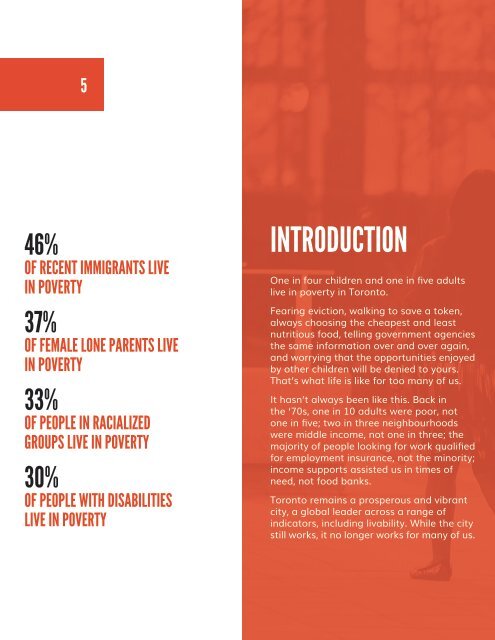TO Prosperity: Toronto Poverty Reduction Strategy
You also want an ePaper? Increase the reach of your titles
YUMPU automatically turns print PDFs into web optimized ePapers that Google loves.
5<br />
46%<br />
OF RECENT IMMIGRANTS LIVE<br />
IN POVERTY<br />
37%<br />
OF FEMALE LONE PARENTS LIVE<br />
IN POVERTY<br />
33%<br />
OF PEOPLE IN RACIALIZED<br />
GROUPS LIVE IN POVERTY<br />
30%<br />
OF PEOPLE WITH DISABILITIES<br />
LIVE IN POVERTY<br />
INTRODUCTION<br />
One in four children and one in five adults<br />
live in poverty in <strong>Toronto</strong>.<br />
Fearing eviction, walking to save a token,<br />
always choosing the cheapest and least<br />
nutritious food, telling government agencies<br />
the same information over and over again,<br />
and worrying that the opportunities enjoyed<br />
by other children will be denied to yours.<br />
That’s what life is like for too many of us.<br />
It hasn’t always been like this. Back in<br />
the ‘70s, one in 10 adults were poor, not<br />
one in five; two in three neighbourhoods<br />
were middle income, not one in three; the<br />
majority of people looking for work qualified<br />
for employment insurance, not the minority;<br />
income supports assisted us in times of<br />
need, not food banks.<br />
<strong>Toronto</strong> remains a prosperous and vibrant<br />
city, a global leader across a range of<br />
indicators, including livability. While the city<br />
still works, it no longer works for many of us.

















